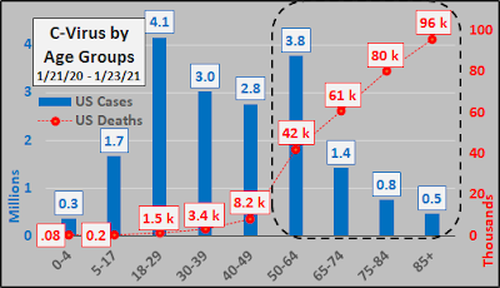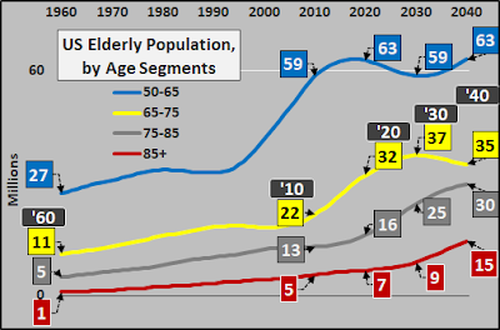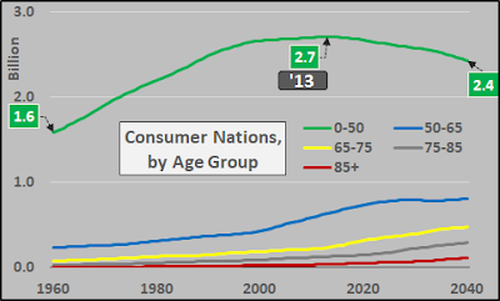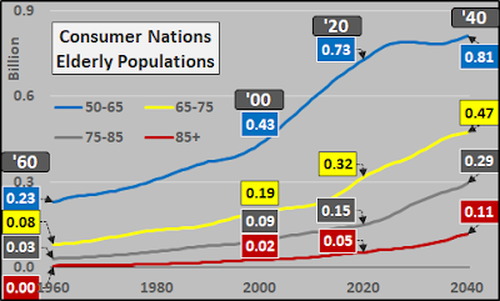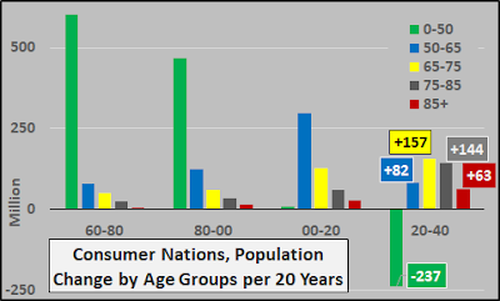Considering A Ballooning At-Risk Elderly Population And Pandemic
Authored by C. Hamilton via econimica.blogspot.com (emphasis ours)
Pretty simple story today. Covid is primarily an old persons disease and the elderly population of “at-risk” is in the process of ballooning, thus Covid (or like diseases that might not have even previously qualified as pandemics)…are finding fertile ground among the significantly enlarging elderly populations.
With almost 96% of the US Covid related deaths among the 50+ year old population, despite the majority (65%) of cases among the under 50 year old population, it should be obvious Covid is a higher risk for elderly than younger persons.
According to the CDC Covid Data Tracker (found HERE), mortality among under 50 year old Covid patients is rare. Of the nearly 12 million cases among under 50 year olds, nearly 13,000 resulted in death (less than 2,000 deaths among the over 6 million cases among under 30 year olds). This is a mortality rate of 0.11% among under 50 year olds. Meanwhile, the 6.4 million Covid cases among 50+ year olds resulted in nearly 280,000 deaths, a mortality rate of 4.57% (yes, CDC data differs from other sources in total cases, deaths…but the CDC demographic breakdown of those deaths is the critical part…bear with me).
Below, mortality rates by age groups. Again, the older the infected, the higher the risk of mortality while, by and large, the immune systems of the under 50 year olds are statistically nearly always up to the task.
The big point we should be discussing is the ballooning of the most at-risk populations over the last decade and ongoing over the next two decades. According to UN World Population Prospects 2019, the 65+ year old US population is amid peak growth…and the highest rates of growth will be shifting to the oldest population segments of 75-85 and 85+ year olds. These populations will double over the next two decades and significantly higher rates of death will be observed due to this. Even a rather tough flu or mild “pandemic” agent among this population will likely see pandemic-like results.
Focusing on the wealthier nations elderly populations, again, the most at-risk segments will see the largest increases in size. Thus, even normal illnesses will have significantly higher mortality rates than previously seen. Even a tough new variant of the flu or new virus like Covid (or Covid mutations) will find multitudes of at-risk elderly with a high likelihood for abnormally higher death rates.
Viewing the population change by age groups over 20 year periods, the current 2020 through 2040 period stands out as something we have never seen. A collapse among the populations of low-risk and explosion of those at high-risk. This must be included in the thinking of what is pandemic and appropriate responses.
Given these demographics, the big question should be; are large numbers of deaths among the vulnerable elderly truly a pandemic? Reason enough to shut down economies, close schools, saddle young with unrepayable quantities of debt? Are there other means to safeguard the elderly while allowing the majority of the world to remain open? Is Covid a one-off or the beginning of virus’ that are mild for the larger population but that will play havoc among the elderly? Are ongoing shut downs and massive increases in debt the appropriate long term response to what is likely a long term problem? Hopefully food for thought.
Tyler Durden
Tue, 01/26/2021 – 18:05
via ZeroHedge News https://ift.tt/36dpAuc Tyler Durden
